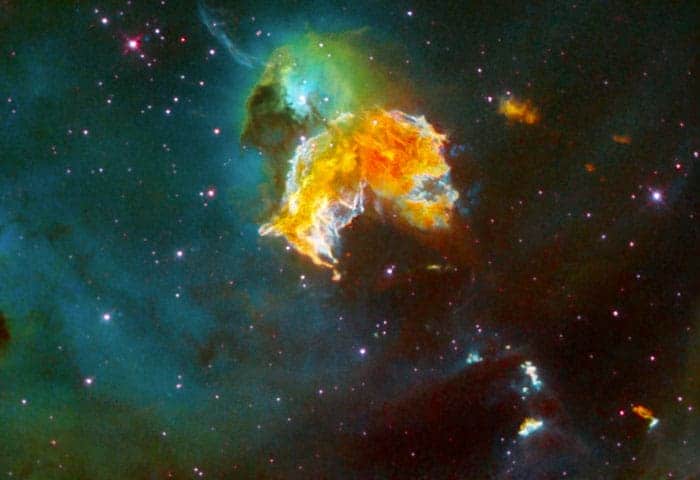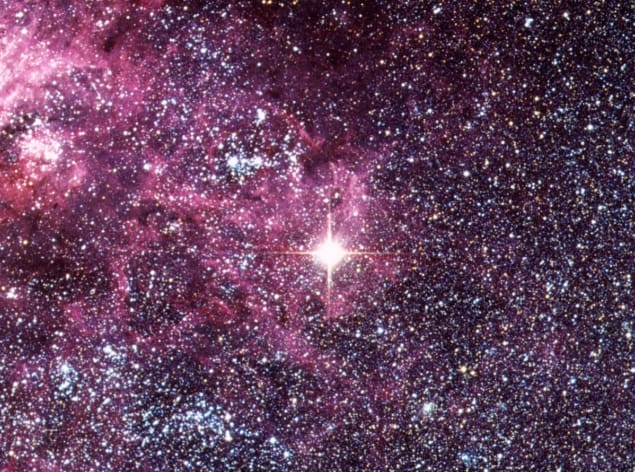Did a supernova trigger the late Devonian extinction?
30 Jul 2020
The explosion of a nearby star could have caused a mass extinction that occurred long ago on Earth. That is the conclusion of a study by an international team of scientists, which suggests that this scenario could be confirmed by looking for a plutonium isotope in fossils.
Around 359 million years ago, at the boundary between the Devonian and Carboniferous periods, the Earth suffered an intense loss of species diversity that lasted for at least 300,000 years. Called the Hangenberg Crisis, the event is thought to have been caused by long-lasting ozone depletion, which would have allowed much more of the Sun’s ultraviolet (UV) radiation to reach and harm life on Earth.
One possible cause of this event is that increased water vapour in the lower stratosphere contributed to a catalytic cycle in which the ozone-damaging free radical chlorine monoxide was produced. However, the duration of this effect would have been far too short to account for the lengthy Hangenberg Crisis. Furthermore, this mechanism would have caused ozone reduction over a limited geographic region, which contradicts evidence that this extinction event was global in nature. Some other mechanism, far more violent and enduring, is therefore be needed to explain the Hangenberg Crisis.
Cosmic rays
In a recent preprint, Brian Fields of the University of Illinois at Urbana–Champaign and colleagues propose a new explanation, arguing that a supernova could have caused the Hangenberg Crisis. Supernovae are exploding stars that release vast quantities of high-energy photons including UV light, X-rays, and gamma rays. These photons are known to collide with interstellar gas, which accelerates charged particles to create cosmic rays.
Cosmic rays from a nearby supernova could have showered the Earth in abundance for up to 100,000 years at a time. This would have continuously depleted the ozone layer on a timescale that would be consistent with the Hangenberg Crisis, and its impact would be global. A supernova could therefore account for both the timescale and the large geographic range of the extinction event, unlike previous hypotheses. Although there are many other candidate astronomical events that could damage the biosphere, such as solar proton events and gamma-ray bursts, these would impact the Earth for just years at a time.
In the preprint, the team suggests that the Hangenberg Crisis was driven by a type of stellar explosion called a core-collapse supernova (CCSN). A CCSN within 10 parsecs (33 light-years) of the Earth would be catastrophic for life on Earth, defining the so-called “kill radius” of such a supernova. The team therefore speculates that the CCSN that caused the Hangenberg Crisis was about 20 parsecs from Earth. This is far enough away not to extinguish the entire biosphere, but close enough to drive many species out of existence.READ MORE

Evidence for such a CCSN could be found in the form of radioactive isotopes created in the supernova and deposited on Earth. While some of these isotopes will have long since decayed away, others have long enough half-lives to still be around. These include samarium-146, uranium-235, and plutonium-244. Indeed, the discovery of even a few plutonium-244 atoms in late Devonian fossils would be corroborating evidence for the supernova hypothesis.
There are other extinction events that occurred earlier in the Devonian period, and it is possible that these could have be caused by other supernovae. Stars tend to be born in clusters, so it is plausible that if one exploding star impacted the Earth, other supernovae could have occurred in the same cluster at around the same time. These, too, would be corroborated by evidence of ozone reduction and radioactive isotopes in the fossil record that could only have been deposited by a supernova. Indeed, we may discover that events in the cosmos have steered the history of life on Earth more than scientists had previously supposed.
Logan Chipkin is a freelance writer based in Philadelphia
from physicsworld.com 23/8/2020

Δεν υπάρχουν σχόλια:
Δημοσίευση σχολίου